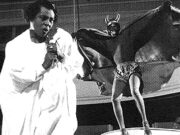Heaven Bound, an African American folk drama that portrays the struggles and pitfalls of a group of pilgrims striving to reach the gates of heaven, was first performed on February 17, 1930, at the Big Bethel African Methodist Episcopal Church in Atlanta. It was hailed soon after as “the first great American folk drama” by the Theatre Guild and has been performed annually ever since.
Origins
Lula B. Jones and Nellie L. Davis, Sunday school teachers and choir members at Big Bethel, wrote the play specifically to aid their financially ailing church. The venerable stone church, located at the center of Atlanta’s Black community on Sweet Auburn Avenue, had been a powerhouse of uplift for African Americans since the days of Reconstruction. The church’s congregation, Atlanta’s oldest, was formed in 1847 when a band of enslaved people assembled to worship with their enslavers in Atlanta’s first church, Union Church. In 1855, these Black men and women broke away to form their own little church, Bethel Tabernacle. The church survived the Civil War (1861-65) and eventually grew to become Big Bethel. In 1923 a new Big Bethel sanctuary, just completed by the last of the church’s freedpeople and their offspring, was ravaged by fire. Facing the depression and hard-pressed for money to pay for the rebuilding effort, the church’s parishioners quickly embraced the idea of Heaven Bound as a means to generate revenue.
The first performances were largely ad-libbed, and included thirty-four players and ten pilgrims. The common church folk who made up the cast interpreted their characters—”The Striver,” “The Hypocrite,” “The Wayward Girl,” and others—using the faith, humor, and resilience that brought them through the Great Depression. Performed in pantomime, the play depicts the conflict between the pilgrims and Satan, who is the main character. Each pilgrim, singing a hymn or spiritual appropriate to the character and the struggle being portrayed, symbolizes one of life’s predicaments or a Christian virtue such as Faith, Hope, or Determination. A beguiling Satan waylays the pilgrims and raises the tension between good and evil. The last pilgrim, a “Soldier in the Army of the Lord,” kills Satan in a heated clash, bringing the play to a climactic end.
Cultural Significance
Heaven Bound pioneered Black theater in the South, building its reputation on the power of Black spirituals and the lure of Black folk mimicry. Because Black people were shut out of mainstream traditional theater, the play maintained its home base at Big Bethel. The church’s high Gothic arches, its huge white chancel, and its projecting pulpit-in-the-round made an impressive setting for “heaven” and became an integral part of the play. Furthermore, Heaven Bound represented dignified theater for Black people. Early critics often compared it withThe Green Pastures (1930), a Pulitzer Prize–winning drama by white playwright Marc Connelly that premiered one week after Heaven Bound. Both plays featured Black actors and spirituals to depict the journey of the pilgrim soul, but Heaven Bound avoided the racially stereotyped dialect, minstrel-like interpretations, and commercial emphasis of The Green Pastures.
With critical acclaim and popular demand at a peak during the 1930s, the play toured cities and towns throughout Georgia and the Southeast. By 1939 it had crystallized in form and become a southern institution. The Heaven Bound choir, cloaked with fame during the depression years, sang for President Franklin D. Roosevelt at his Little White House in Warm Springs. The choir also rendered foot-stamping spirituals at the 1939 world premiere of Gone With the Wind in Atlanta. The prestige and wide appeal of Heaven Bound gave it a unique role as a social force and agent of change in the Atlanta community. The play’s interaction between cast and audience furthered the city’s agenda for interracial dialogue and goodwill. The Black and white people who annually packed Big Bethel’s 1,500-seat sanctuary to see the drama seated themselves in an integrated fashion even while racial segregation was still the law.
Legacy
Although Big Bethel’s financial emergency gave rise to Heaven Bound, the play had deep cultural roots in the Black experience. Its real inspiration was the historical, heaven-focused pilgrimage of African Americans from enslavement into the twentieth century. When the play debuted in 1930, its parade of saints struck up to the tune of the trademark Black spiritual “When the Saints Go Marching In,” followed by old Methodist hymns and other spirituals such as “Great Day de Righteous Marchin’,” “I’m Trampin’,” and “My Lord’s a-Writin’ All de Time.” The first “Saint Peter” was an elderly, formerly-enslaved man who belonged to Big Bethel’s congregation. The influence of slavery on Heaven Bound was a point lost on several scholars who attempted to compare it with earlier literary tradition. The “heaven” of this play was the heaven of America’s enslaved people, not the one that figured in Europe’s medieval morality plays or John Bunyan’s Pilgrim’s Progress. This distinction was critical to the message and promise of Heaven Bound.
The feverish pace of hundreds of performances during the 1930s slowed considerably in the early 1940s. Because the cast had sustained injuries from stage sets built hastily in unfamiliar places, Big Bethel restricted the cast to two performances a year. Typically these were staged in the church’s large sanctuary. The popularity of Heaven Bound continued, however, as evidenced by a 1953 pictorial essay in Life magazine. By 1971 the play had seen almost eight hundred performances and more than one million ticket sales since its debut. Five years later the New York Times cited it as “one of Atlanta’s most enduring traditions.” By the turn of the century Heaven Bound had become one of the longest continuously running theater productions in the nation.




